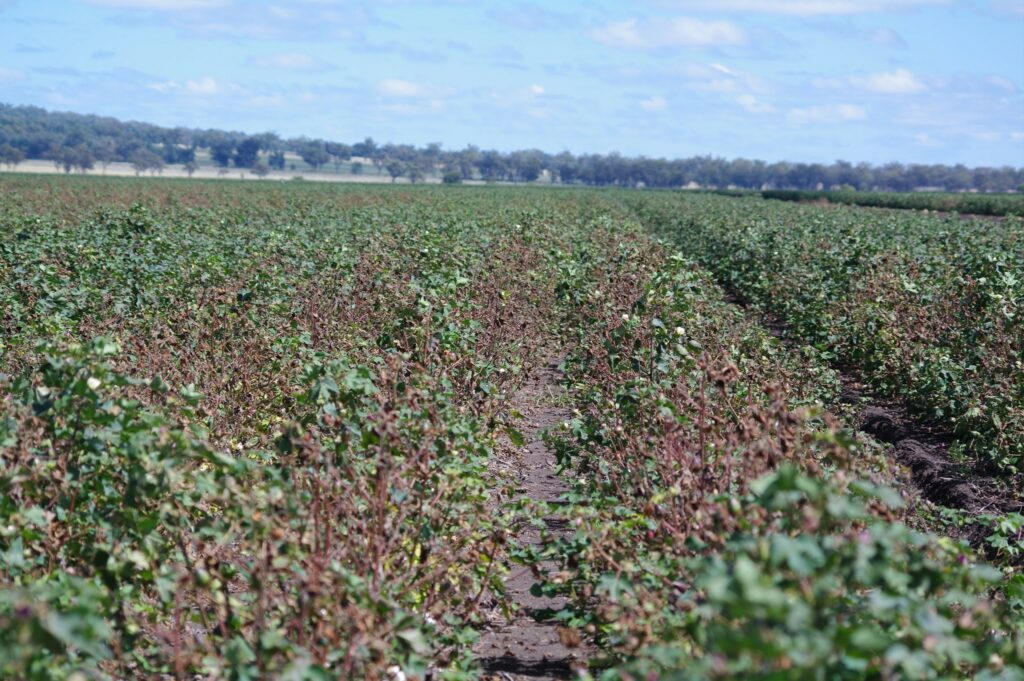Disease suppressive soils – nature’s solution to pathogens
What are they?
Disease suppressive soils are those with the ability to limit infection from soilborne pathogens and the severity of disease, even in the presence of the pathogen and a susceptible host. The suppression of disease in these soils is because of the community of microbes specific to these soils. How the soil microbiome supresses the disease isn’t full understood. However, researchers believe this could occur because of competition between pathogens and microbial community for energy and nutrient sources or root binding sites, antagonism through the production of enzymes and other antimicrobial compounds that inhibit the growth and infection by the plant pathogen.

Crops devastated by Verticilium wilt.
Soilborne diseases are a major threat to crop productivity in Australia and worldwide. One such pathogen, Rhizoctonia solani AG8, is known for causing root rot and bare patch disease in a range of cereal crops in non-suppressive soils and has been estimated to cause $77 million damage to wheat and barley per annum. Similarly, Verticilium wilt, caused by Verticillium dahliae, is one of the most important diseases of cotton worldwide causing up to 45% yield losses. There are no reliable chemical or plant resistance-based options for controlling these diseases. However, biologically controlled suppression of these diseases because of the soil and plant microbiomes has been documented in defined areas in Australia.
Why are they important?
Researchers at CSIRO and MOSH FSP are investigating disease suppressive microbiomes in cereals and cotton crops focussing on understanding the soil, management and plant factors that govern soil’s disease suppression capacity. Multi-omic techniques combined with microbial ecology approaches will be used to understand the make of the suppressive soil microbiomes, how they assemble, the genetic mechanisms and metabolic pathways that result in disease suppression. With this knowledge, targeted interventions can be developed to enhance the biological suppression of diseases caused by soilborne pathogens such as R. solani and V. dahlia. The knowledge gained from this research could provide specific management options that can accelerate disease suppression development in different crops, soil types and regions. This would significantly help prevent production losses from soilborne diseases and provides farmers opportunities to implement sustainable cropping practices.
References and further information
Do small RNAs unlock the below ground microbiome-plant interaction mystery? – https://www.frontiersin.org/articles/10.3389/fmolb.2022.1017392/full
Rhizosphere microbial communities associated with Rhizoctonia damage at the field and disease patch scale – https://doi.org/10.1016/j.apsoil.2014.02.001
Fungal Community Structure in Disease Suppressive Soils Assessed by 28S LSU Gene Sequencing – https://doi.org/10.1371/journal.pone.0093893
Comparative Metatranscriptomics of Wheat Rhizosphere Microbiomes in Disease Suppressive and Non-suppressive Soils for Rhizoctonia solani AG8 – https://doi.org/10.3389/fmicb.2018.00859
Organic matter input influences incidence of root rot caused by Rhizoctonia solani AG8 and microorganisms associated with plant root disease suppression in three Australian agricultural soils https://doi.org/10.1071/SR18345
The team
Dr Gupta Vadakattu Senior Principal Research Scientist, Functional Soil Biology
Dr Roshan Regmi Postdoctoral Fellow, Functional Soil Biology
Stasia Kroker – Research Officer, Microbiology and functions
Marcus Hicks – Research Officer, Molecular microbiology
Dr Simon Law Research Scientist, Biotic Interactions
